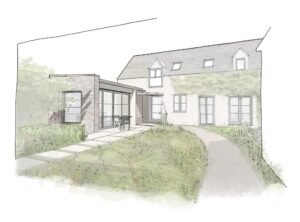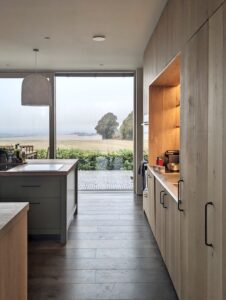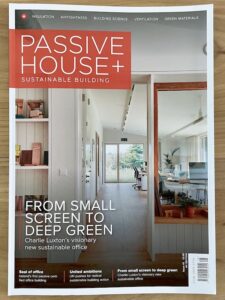All too often sustainable solutions are used only as a means of reducing energy bills. Charlie reveals how these features could improve the quality of spaces too.
For most, the driving force behind building a low-energy home is saving energy and, therefore, money. Undoubtedly the idea of saving the planet comes into it, but the reality comes down to low energy bills.
My design work is focused on new builds, extensions and refurbishments, all driven by a desire to be as sustainable as the client, brief and budget will allow. Through this I’ve come to believe that the reason for the take-up of sustainable building techniques is solely concentrated on money saving and payback, but people should instead be investing more in airtightness, insulation and triple glazing to create quality spaces. Still, calm, healthier and quiet — properly built, low-energy spaces are far nicer places to live. Once you’ve experienced low-energy housing you will never want to live in a draughty, cold old house again.
Comfortable, good for wellbeing, lower bills and doing your bit to conserve the planet — it sounds too good to be true. The downside is that while cheaper in the long run, low-energy construction costs more upfront. There are, however, some simple sustainable design principles that can be adopted to help make your home green.
Smart Design
One of the best things to come out of the eco sector is thermal modelling. This is the ability to use computer programmes to test the energy, thermal and water performance of a design as it evolves, and allows designers to optimise a building’s shape, orientation, windows and insulation to passively use the sun to do as much heating and lighting as possible. It goes hand-in-hand with a fabric-first approach rather than focusing, as many do, on how to heat the house through low-carbon technologies such as heat pumps, photovoltaic panels or biomass boilers. I would never design a new house without using thermal modelling to inform the process.
Overheating
All these homes with large south-facing windows and lots of insulation are wonderful, but many new builds suffer from overheating. With our climate set to warm considerably over the next 50 years this is only going to get worse. Test your home for possible overheating at the outset using thermal modelling and design it out at an early stage.
Size
The bigger the house, the bigger the bills (we calculate energy consumption through kW/m2/annum) — so try to make internal spaces work harder for you rather than just creating more rooms. Small can be beautiful and this will allow you to spend more money per m2 to get better quality spaces.
Insulation
It certainly isn’t sexy, but to create super comfortable low-energy homes, insulation is your biggest asset. Critically we are not talking about a few tatty layers of fibreglass in the loft — we are talking a minimum of 300mm-thick insulation which is properly installed. It is a case of insulating as much as possible, and then some more!
Cold Bridges
The key to insulation is lots of it, but you must also have total continuity. Any gaps or bits of structure (lintels, masonry, timbers) that bridge the insulation layer not only lose heat but moisture condensates on the resultant cold spots too. This often leads to mould – a big health risk – so you have to be very careful that your insulation layer is carefully designed.
Windows
Windows are important to get right, especially as they are replaced so infrequently. A house will usually go through multiple boilers before any of the windows are replaced, so opt for triple glazing for new builds and at least double glazing for existing homes. It is not just the quality of the windows, but how they are fitted is equally important. Air leakage around windows is a big problem and using the right foams, sealing tapes and fixings is critical.
Airtightness
After insulation, airtightness is vital. This means sealing up all the gaps and holes in your building. Draughts and air movement within a dwelling have a huge impact on the comfort of a home. The perfect internal temperature for most in a well-sealed, draught-free house is 19°C, but if there are draughts then achieving 21°C is required for a comfortable temperature. This seemingly small rise in temperature will have a big impact on your comfort and energy bills.
Heat Recovery
After a house has been highly insulated and sealed, the biggest source of heat loss will be ventilation. People need lots of fresh air to be healthy and to provide this and maintain airtightness you need a mechanical ventilation heat recovery (MVHR) unit. This is a system that extracts warm, moist air from bathrooms, kitchens and utilities by passing it through a heat exchanger to preheat fresh air from the outside which is then pumped into the bedrooms, sitting rooms, etc. It provides up to around four times the ventilation rates in a normal home and filters the air for dust, pollen and pollutants. In a well-insulated airtight house it will halve energy consumption and give fresh, warm clean air — it’s one of the best bits of technology to come into the low-energy sector.
Air Quality
In terms of creating low-energy, comfortable but also healthy homes, good internal air quality is crucial. MVHR systems help by upping the ventilation rates, reducing moisture and filtering air that comes into the house, but I am also always very careful to try and specify low toxicity and low off-gassing materials. My rule of thumb is that if I would eat my dinner off it, I will put it in a house! Think about reducing the use of MDF, particleboard and petroleum-based products and consider materials with low toxin levels instead.
Stay Positive
It is easy with all the additional complexity these issues bring to lose sight of the fact that your house should be joyful and inspiring. Sometimes low-energy architecture can become a little too worthy and rational. You need a bit of magic and sparkle in a project — don’t let low-energy concerns kill that. Whether you’re dealing with a new build or refurbishment, low-energy homes are not easy to achieve but once you do it, you’ll never go back. Super sleek £50,000 kitchens and cinema rooms are the luxuries of today; low-energy homes are the luxury of tomorrow.











